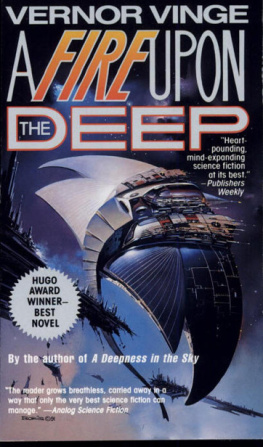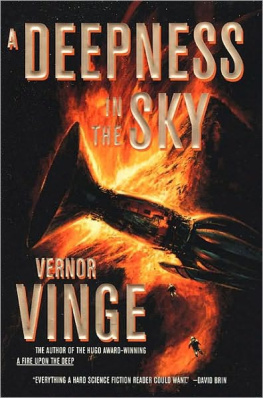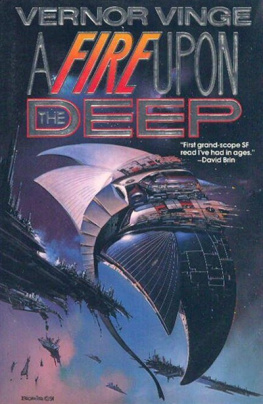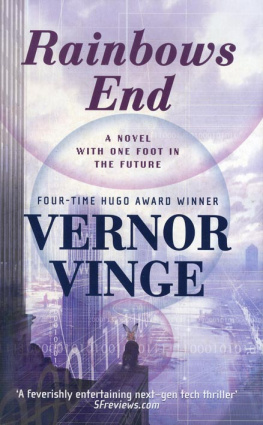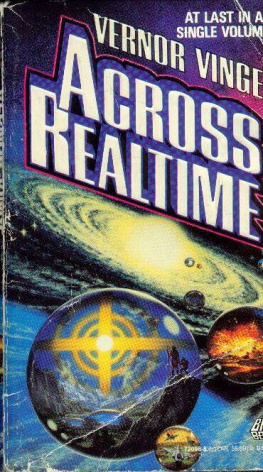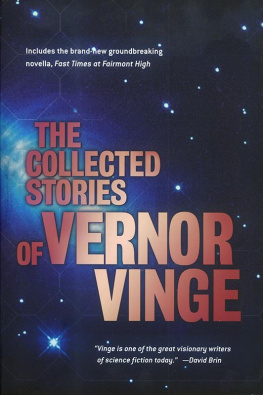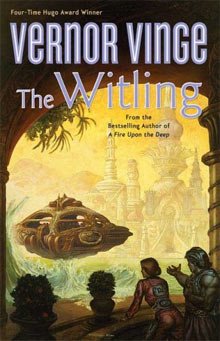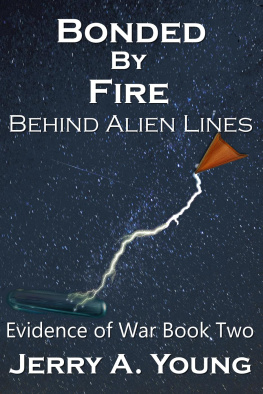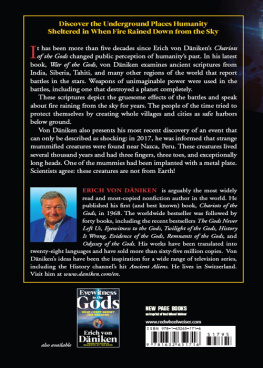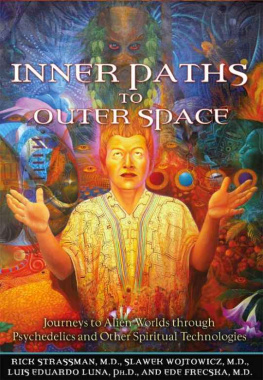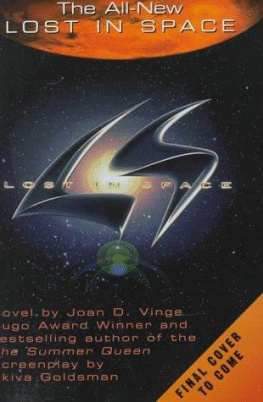A Fire Upon the Deep
Special Edition eBook
Vernor Vinge
A TOM DOHERTY ASSOCIATES BOOK
New York
www.ebookyes.com
This is a work of fiction. All the characters and events portrayed in this novel are either fictitious or are used fictitiously.
A FIRE UPON THE DEEP
Copyright 2002 by Vernor Vinge
All rights reserved, including the right to reproduce this book, or portions thereof, in any form.
Edited by James Frenkel
A Tor Book
Published by Tom Doherty Associates, Inc.
175 Fifth Avenue
New York, NY 10010
Tor Books on the World Wide Web:
http://www.tor.com
Tor is a registered trademark of Tom Doherty Associates, Inc.
eISBN 0-312-70369-4
ALSO BY VERNOR VINGE
Tatja
Grimms World
The
Witling
True
Names and Other Dangers (collection)
Threats
and Other Promises (collection)
Across
Realtime
comprising:
The Peace War
The Ungoverned
Marooned in Realtime
* A
Fire Upon the Deep
* A
Deepness in the Sky
* Collected
Stories of Vernor Vinge
* True
Names and the Opening of the Cyberspace Frontier
*denotes a Tor book
Acknowledgments
I am grateful for the advice and help of: Jeff Allen, Robert Cademy, John Carroll, Howard L. Davidson, Michael Gannis, Gordon Garb, Corky Hansen, Dianne L. Hansen, Sharon Jarvis, Judy Lazar, and Joan D. Vinge.
I am very grateful to James R. Frenkel for the wonderful job of editing he has done with this book.
Thanks to Poul Anderson for the quote that I use as the motto of the Qeng Ho.
During the summer of 1988, I visited Norway. Many things I saw there influenced the writing of this story. I am very grateful to: Johannes Berg and Heidi Lyshol and the Aniara Society for showing me Oslo and for wonderful hospitality; the organizers of the Arctic 88 distributed systems course at the University of Troms, in particular Dag Johansen. As for Tromsy and the surrounding lands: I had not dreamed that so pleasant and beautiful a place could exist in the arctic.
Science Fiction has imagined many alien creatures; this is one of the genres great charms. I dont know what in particular inspired me to make the Riders in this novel, but I do know that Robert Abernathy wrote about a similar race in his short story, Junior ( Galaxy , January 1956). Junior is a beautiful commentary on the spirit of life.
[Added in 2002: Im grateful to Brad Templeton for suggesting, way back in 1993, that the annotated version of the manuscript should be published. Thanks also to various members of the USENET science-fiction community for encouraging republication of the annotated version in 2002.
Thanks to Jeff Gomez of St. Martins Press for shepherding this republication, and to Ken Brooks of Publishing Dimensions for transforming my flat ascii into the forms used here.]
Dedication
To my father, Clarence L. Vinge, with love.
V. V.
Behind the Scenes of A Fire Upon the Deep
[This introduction was originally written in 1993, before the rise of the Web. I have edited the intro somewhat, but I dont think I have changed any technological prognostications.]
A Primitive Form of Story Documentation
Since 1979 Ive used the manuscript convention that lines beginning with ^ should not normally be printed. This makes it easy for me to comment my text. Over the years, as storage capacities increased, I found that even this extremely crude tactic could be very helpful in story development. About one fourth of my Fire Upon the Deep manuscript is such hidden commentary. These comments served a variety of purposes, and I used various tag words to discriminate between these purposes (see the table below). Besides formal tags, I had a large number of key words to identify different aspects of the story. I used several tools mainly grep to follow the key words around the manuscript. Note that this technique is not hypertext ( well, maybe it could be called a manual form of hypertext, with grep being used to dynamically compute links :-).
In 1993, Brad Templeton of Clarinet published a CDROM, Hugo and Nebula Anthology 1993 , that included a version of this annotated manuscript. (And this introduction is only slightly modified from the one in that CDROM.) I think the annotated manuscript was fun for people who wanted to look behind the scenes at a story as it is being constructed. Im happy that it will see the light of day again!
In preparing the manuscript notes for publication, I tried to extend and clean up the notes. However, I want to warn you that since these are mainly internal development notes, they are often cryptic, repetitive, and inconsistent. (The notes are also tentative in the sense that they may be contradicted by later-written sequels and prequels.) There are interesting things in these notes, but you can get lost in the tedium of minor issues or be led astray by discussion of problems that were later solved (leaving the discussion without referent!). Hopefully, this introduction will make it more convenient for people who do want to look at the notes.
A Zoology of Annotations
In the formatting of this 2002 edition, comments are easily identified by their graphical layout. In my own plain ascii files, I used very much cruder conventions. Those are mostly invisible in this edition, but I list them here for people who are curious to know what the raw (text editor friendly) version would look like:
I delimit italicized text with underscores. (I dont have any page-long italicized passages, so any such are probably due to loss of underscore-parity.)
Embedded comments have ^ as the first non-whitespace on the line. Commands to my formatter (inherited from Kernighan and Plaugers Software Tools , Addison-Wesley, 1976!) use a similar convention: ^bp page break ^ls n linespacing ^he s define page header ^fo s define page footer
My formatter prints the pair ampersand numbersign ( ) as a single numbersign ( # ). Thus, I use as a section break. When a numbersign ( # ) is not preceded by an ampersand, it is supposed to be a single space. (I use this character to force vertical whitespace and as part of the indent for paragraphs.)
Where the first alpha characters on a line are NOTE, you are normally seeing a note to the copyeditor. (I use this mostly to flag the beginning of monospace font (eg, Courier) for the Net messages.)
I use tags a lot. In a sense almost anything could become a tag (and a target for grep), but the most formalized tags and their meanings are as follows.
AWK
The referenced prose seems awkward. (Hopefully most of these are fixed.)
BKG
The comment is background.
CHAR
The comment is related to some character issue.
CHKd
Issue from CHK comment has been verified.
CHK
The comment involves something that I should verify.
CHRON
The comment requires a check of the consistency of the timing or sequence of the story
DEL
Delete
DONE
The action suggested in the comment has been done.
FIXED
I fixed the problem raised by the question.
FIX
Same as FIXED.
FRAG
The commented text is a fragment either something that is looking for a home in the manuscript, or perhaps the reverse, namely text that has been removed/replaced. In the latter case, the fragment may contradict the published story line.
iD
An idea that has either been incorporated or eleminated from consideration.
ID

